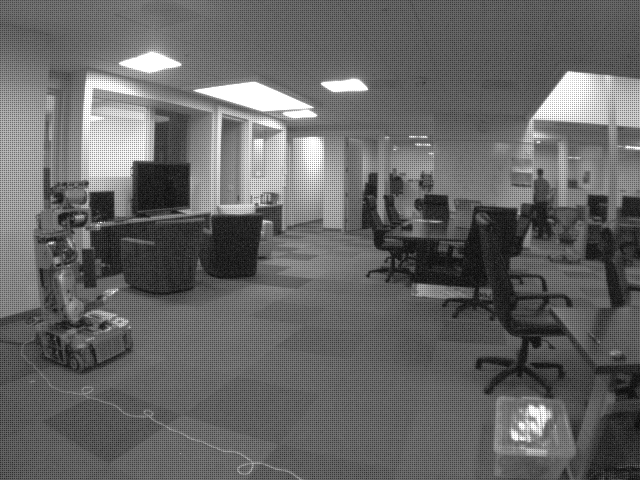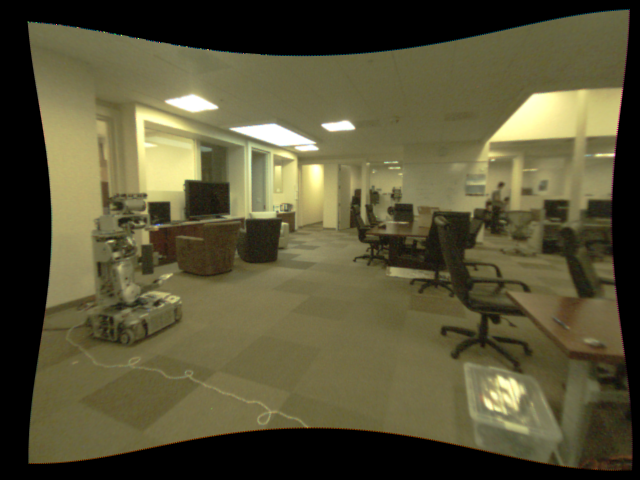Show EOL distros:
Package Summary
Single image rectification and color processing.
- Author: Patrick Mihelich, Kurt Konolige, Jeremy Leibs
- License: BSD
- Repository: ros-pkg
- Source: svn https://code.ros.org/svn/ros-pkg/stacks/image_pipeline/tags/image_pipeline-1.4.2
Package Summary
Single image rectification and color processing.
- Author: Patrick Mihelich, Kurt Konolige, Jeremy Leibs
- License: BSD
- Repository: ros-pkg
- Source: svn https://code.ros.org/svn/ros-pkg/stacks/image_pipeline/tags/image_pipeline-1.6.4
Package Summary
Single image rectification and color processing.
- Author: Patrick Mihelich, Kurt Konolige, Jeremy Leibs
- License: BSD
- Source: git https://github.com/ros-perception/image_pipeline.git (branch: fuerte-devel)
Package Summary
Single image rectification and color processing.
- Maintainer status: maintained
- Maintainer: Vincent Rabaud <vincent.rabaud AT gmail DOT com>
- Author: Patrick Mihelich, Kurt Konolige, Jeremy Leibs
- License: BSD
- Source: git https://github.com/ros-perception/image_pipeline.git (branch: groovy-devel)
Package Summary
Single image rectification and color processing.
- Maintainer status: maintained
- Maintainer: Vincent Rabaud <vincent.rabaud AT gmail DOT com>
- Author: Patrick Mihelich, Kurt Konolige, Jeremy Leibs
- License: BSD
- Source: git https://github.com/ros-perception/image_pipeline.git (branch: hydro-devel)
Package Summary
Single image rectification and color processing.
- Maintainer status: maintained
- Maintainer: Vincent Rabaud <vincent.rabaud AT gmail DOT com>
- Author: Patrick Mihelich, Kurt Konolige, Jeremy Leibs
- License: BSD
- Source: git https://github.com/ros-perception/image_pipeline.git (branch: indigo)
Package Summary
Single image rectification and color processing.
- Maintainer status: maintained
- Maintainer: Vincent Rabaud <vincent.rabaud AT gmail DOT com>
- Author: Patrick Mihelich, Kurt Konolige, Jeremy Leibs
- License: BSD
- Source: git https://github.com/ros-perception/image_pipeline.git (branch: indigo)
Package Summary
Single image rectification and color processing.
- Maintainer status: maintained
- Maintainer: Vincent Rabaud <vincent.rabaud AT gmail DOT com>
- Author: Patrick Mihelich, Kurt Konolige, Jeremy Leibs
- License: BSD
- Source: git https://github.com/ros-perception/image_pipeline.git (branch: indigo)
Package Summary
Single image rectification and color processing.
- Maintainer status: maintained
- Maintainer: Vincent Rabaud <vincent.rabaud AT gmail DOT com>
- Author: Patrick Mihelich, Kurt Konolige, Jeremy Leibs
- License: BSD
- Source: git https://github.com/ros-perception/image_pipeline.git (branch: indigo)
Package Summary
Single image rectification and color processing.
- Maintainer status: developed
- Maintainer: Vincent Rabaud <vincent.rabaud AT gmail DOT com>, Steven Macenski <stevenmacenski AT gmail DOT com>, Autonomoustuff team <software AT autonomoustuff DOT com>
- Author: Patrick Mihelich, Kurt Konolige, Jeremy Leibs
- License: BSD
- Source: git https://github.com/ros-perception/image_pipeline.git (branch: melodic)
Package Summary
Single image rectification and color processing.
- Maintainer status: maintained
- Maintainer: Vincent Rabaud <vincent.rabaud AT gmail DOT com>, Autonomoustuff team <software AT autonomoustuff DOT com>
- Author: Patrick Mihelich, Kurt Konolige, Jeremy Leibs
- License: BSD
- Source: git https://github.com/ros-perception/image_pipeline.git (branch: noetic)
Contents
Overview
This package contains the image_proc node, which is meant to sit between the camera driver and vision processing nodes. image_proc removes camera distortion from the raw image stream, and if necessary will convert Bayer or YUV422 format image data to color.
Monocular processing example |
|
|
|
image_raw: Original camera image, Bayered and distorted |
image_rect_color: Rectified image, de-Bayered and undistorted (amount of black border may vary depending on calibration) |
New in ROS Electric image_proc also contains the crop_decimate nodelet, which applies decimation and ROI to a raw image in software.
Mini Tutorial
Make sure your camera driver is running. You can check rostopic list | grep image_raw to see the available raw image topics from compatible drivers.
Normally the raw image from the camera driver is not what you want for visual processing, but rather an undistorted and (if necessary) debayered image. This is the job of image_proc. If you are running on a robot, it's probably best to run image_proc there. For example, if the driver is publishing topics /my_camera/image_raw and /my_camera/camera_info you would do:
$ ROS_NAMESPACE=my_camera rosrun image_proc image_proc
Notice that we push our image_proc instance down into the /my_camera namespace, in which it subscribes to the image_raw and camera_info topics. All output topics are likewise published within the /my_camera namespace.
In a separate terminal (on your home machine, if you are running on a robot):
$ rosrun image_view image_view image:=my_camera/image_rect_color
This will display an undistorted color image from "my_camera".
Nodes
image_proc

De-mosaics and undistorts the raw camera image stream.
All processing is on demand. Color processing is performed only if there is a subscriber to a color topic. Rectification is performed only if there is a subscriber to a rectified topic. While there are no subscribers to output topics, image_proc unsubscribes from the image_raw and camera_info topics.
image_transport is used for all publications and subscriptions.
Subscribed Topics
image_raw (sensor_msgs/Image)- Raw image stream from the camera driver.
- Camera metadata.
Published Topics
image_mono (sensor_msgs/Image)- Monochrome unrectified image.
- Monochrome rectified image.
- Color unrectified image.
- Color rectified image.
Parameters
~queue_size (int, default: 5)- Size of message queue for synchronizing image and camera_info topics. You may need to raise this if images take significantly longer to travel over the network than camera info.
Nodelets
New in Diamondback, this package contains nodelets for the tasks of debayering and rectification. This allows image_proc functions to be easily combined with other nodelets, for example camera drivers or higher-level vision processing. In fact, the image_proc node simply loads one debayer nodelet and two rectify nodelets.
image_proc/debayer
Takes a raw camera stream and publishes monochrome and color versions of it. If the raw images are Bayer pattern, it debayers using bilinear interpolation.Subscribed Topics
image_raw (sensor_msgs/Image)- Raw image stream from the camera driver.
Published Topics
image_mono (sensor_msgs/Image)- Monochrome image.
- Color unrectified image.
Parameters
Dynamically Reconfigurable Parameters
See the dynamic_reconfigure package for details on dynamically reconfigurable parameters.- Debayering algorithm. Possible values are:
- Bilinear (0): Fast algorithm using bilinear interpolation
- EdgeAware (1): Edge-aware algorithm
- EdgeAwareWeighted (2): Weighted edge-aware algorithm
- VNG (3): Slow but high quality Variable Number of Gradients algorithm
image_proc/rectify
Takes an unrectified image stream and its associated calibration parameters, and produces rectified images.Subscribed Topics
image_mono (sensor_msgs/Image)- Unrectified image stream.
- Camera metadata.
Published Topics
image_rect (sensor_msgs/Image)- Rectified image.
Parameters
~queue_size (int, default: 5)- Size of message queue for synchronizing image and camera_info topics. You may need to raise this if images take significantly longer to travel over the network than camera info.
Dynamically Reconfigurable Parameters
See the dynamic_reconfigure package for details on dynamically reconfigurable parameters.- Interpolation algorithm between source image pixels. Possible values are:
- NN (0): Nearest neighbor
- Linear (1): Linear
- Cubic (2): Cubic
- Lanczos4 (4): Lanczos4
image_proc/crop_decimate
Applies decimation (software binning) and ROI to a raw camera image post-capture. Remap camera and camera_out to the desired input/output camera namespaces.Subscribed Topics
camera/image_raw (sensor_msgs/Image)- Raw image stream from the camera driver.
- Camera metadata.
Published Topics
camera_out/image_raw (sensor_msgs/Image)- Cropped and decimated "raw" image.
- Camera metadata, with binning and ROI fields adjusted to match output raw image.
Parameters
~queue_size (int, default: 5)- Size of message queue for synchronizing image and camera_info topics. You may need to raise this if images take significantly longer to travel over the network than camera info.
Dynamically Reconfigurable Parameters
See the dynamic_reconfigure package for details on dynamically reconfigurable parameters.- Number of pixels to decimate to one horizontally. Range: 1 to 16
- Number of pixels to decimate to one vertically. Range: 1 to 16
- X offset of the region of interest. Range: 0 to 2447
- Y offset of the region of interest. Range: 0 to 2049
- Width of the region of interest. Range: 0 to 2448
- Height of the region of interest. Range: 0 to 2050
~interpolation (int, default: 0)
- Sampling algorithm. Possible values are:
- NN (0): Nearest-neighbor sampling
- Linear (1): Bilinear interpolation
- Cubic (2): Bicubic interpolation over 4x4 neighborhood
- Area (3): Resampling using pixel area relation
- Lanczos4 (4): Lanczos interpolation over 8x8 neighborhood
New in ROS Indigo
image_proc/resize
Takes image and/or camera info and resize them.Subscribed Topics
image (sensor_msgs/Image)- Arbitrary image.
- Camera parameters.
Published Topics
~image (sensor_msgs/Image)- Resized image.
- Resized camera info.
Launch files
New in ROS Fuerte
image_proc.launch
Loads debayer and rectify nodelets for one camera into a user-provided nodelet manager. The in-process equivalent of running the image_proc node. Launch (or include in a higher-level launch file) in the camera namespace, just as you would run image_proc.
Arguments
manager (string)
- The name of the target nodelet manager. It will need to be globally qualified (e.g. /my_manager), unless the manager is already in the camera namespace.
- If true, enables bond topics and respawns any nodelet loaders that die. If the manager also respawns, the system is robust to any node dying. However, the proliferation of bond topics can overwhelm introspection tools like rxgraph.
Subscribed and Published Topics
Identical to the image_proc node.









